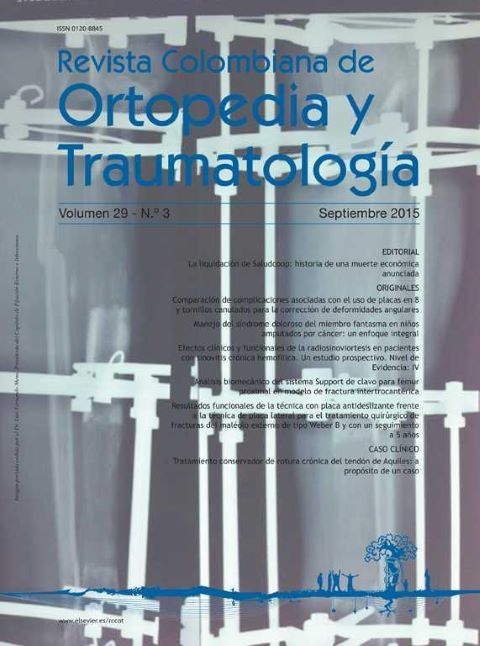Manejo del síndrome doloroso del miembro fantasma en niños amputados por cáncer: un enfoque integral
DOI:
https://doi.org/10.1016/j.rccot.2016.02.004Palabras clave:
dolor, miembro fantasma, neoplasias, niñosResumen
El propósito de la revisión fue extraer de la bibliografía recomendaciones para el manejo del miembro fantasma doloroso en niños amputados por cáncer, resumidas en una propuesta de un manejo integral.
El síndrome doloroso del miembro fantasma se presenta en el 48-80% de los amputados, ocasiona deterioro de la calidad de vida, incremento del costo de la atención sanitaria y dificulta su rehabilitación. La fisiopatología de esta entidad incluye la interacción de mecanismos periféricos y el procesamiento anormal de la información en el sistema nervioso central.
Su manejo requiere intervenciones enfocadas a la prevención y tratamiento temprano. Las opciones farmacológicas incluyen gabapentinoides, opioides y anti-NMDA (N-metil-D-aspartato). En conclusión, no hay consenso en cuanto a su manejo. Los puntos clave incluyen el control óptimo del dolor previo a la cirugía, el manejo multidisciplinario con clínica del dolor, salud mental, trabajo social y rehabilitación como modelo de atención del paciente amputado.
Nivel de evidencia clínica: Nivel IV.
Descargas
Referencias bibliográficas
Terselich G, Martínez T, Vega RM. Cáncer en niños y adolescentes en el Instituto Nacional de Cancerología (INC), Bogotá, Colombia: revisión de dos décadas. Rev Col Cancerol. 2002;6:50-66.
Smith J, Thompson JM. Phantom limb pain and chemotherapy in pediatric amputees. Mayo Clin Proc. 1995;70:357-64. https://doi.org/10.4065/70.4.357
Krane EJ, Heller LB. The prevalence of phantom sensation and pain in pediatric amputees. J Pain Symptom Manage. 1995;10:21-9. https://doi.org/10.1016/0885-3924(94)00062-P
Pell JP, Donnan PT, Fowkes FG, Ruckley CV. Quality of life following lower limb amputation for peripheral arterial disease. Eur J Vasc Surg. 1993;7:448-51. https://doi.org/10.1016/S0950-821X(05)80265-8
Sherman RA. Phantom limb pain. Mechanism-based management. Clin Podiatr Med Surg. 1994;11:85-106. https://doi.org/10.1016/S0891-8422(23)00657-2
Halbert J, Crotty M, Cameron I. Evidence for the optimal management of acute and chronic phantom pain: A systematic review. Clin J Pain. 2002;18:84-92. https://doi.org/10.1097/00002508-200203000-00003
Wilkins KL, McGrath PJ, Finley GA, Katz J. Phantom limb sensations and phantom limb pain in child and adolescent amputees. Pain. 1998;78:7-12. https://doi.org/10.1016/S0304-3959(98)00109-2
Thomas CR, Brazeal BA, Rosenberg L, Robert RS, Blakeney PE, Meyer WJ. Burns. 2003;29:139-42. https://doi.org/10.1016/S0305-4179(02)00281-4
Burgoyne L, Billups C, Jiron J, Kaddoum R, Wright B, Bikhazi G, et al. Phantom limb pain in young cancer-related amputees recent experience at St Jude Children's Research Hospital. Clin J Pain. 2012;28:222-5. https://doi.org/10.1097/AJP.0b013e318227ce7a
Jensen TS, Krebs B, Nielsen J, Rasmussen P. Immediate and long-term phantom limb pain in amputees: incidence, clinical characteristics and relationship to pre-amputation limb pain. Pain. 1985;21:267-78. https://doi.org/10.1016/0304-3959(85)90090-9
Hanley MA1, Jensen MP, Smith DG, Ehde DM, Edwards WT, Robinson LR. Preamputation pain and acute pain predict chronic pain after lower extremity amputation. J Pain. 2007;8:102-9. https://doi.org/10.1016/j.jpain.2006.06.004
Kooijman CM, Dijkstra PU, Geertzen JH, Elzinga A, Cees P, Van Der Schanz CP. Phantom pain and phantom sensations in upper limb amputees: an epidemiological study. Pain. 2000;87:33-41. https://doi.org/10.1016/S0304-3959(00)00264-5
Price EH. A critical review of congenital phantom limb cases and a developmental theory for the basis of body image. Conscious Cogn. 2006;2:310-22. https://doi.org/10.1016/j.concog.2005.07.003
Dijkstra PU, Geertzen JH, Stewart R, Van der Schans CP. Phantom pain and risk factors: A multivariate analysis. J Pain Symptom Manage. 2002;6:578-85. https://doi.org/10.1016/S0885-3924(02)00538-9
Jensen MP, Ehde DM, Hoffman AJ, Patterson DR, Czerniecki JR, Robinson LR. Cognitions, coping and social environment predict adjustment to phantom limb pain. Pain. 2002;95:133-42. https://doi.org/10.1016/S0304-3959(01)00390-6
Wall PD, Gutnick M. Ongoing activity in peripheral nerves: the physiology and pharmacology of impulses originating from a neuroma. Exp Neurol. 1974;43:580-93. https://doi.org/10.1016/0014-4886(74)90197-6
Flor H. Phantom-limb pain: characteristics, causes, and treatment. Lancet Neurol. 2002;1:182-9. https://doi.org/10.1016/S1474-4422(02)00074-1
Flor H, Nikolajsen L. Staehelin Jensen T. Phantom limb pain: a case of maladaptive CNS plasticity. Nat Rev Neurosci. 2006;7:873-81. https://doi.org/10.1038/nrn1991
Weeks SR, Anderson-Barnes VC, Tsao JW. Phantom limb pain theories and therapies. Neurologist. 2010;16:277-86. https://doi.org/10.1097/NRL.0b013e3181edf128
Ramachandran VS, Rogers-Ramachandran D, Stewart M. Perceptual correlates of massive cortical reorganization. Science. 1992;258:1159-60. https://doi.org/10.1126/science.1439826
Flor H, Elbert T, Knecht S. Phantom limb pain as a perceptual correlate of cortical reorganization following arm amputation. Nature. 1995;357:482-4. https://doi.org/10.1038/375482a0
Birbaumer N, Lutzenberger W, Montoya P, et al. Effects of regional anesthesia on phantom limb pain are mirrored in changes in cortical reorganization. J Neurosci. 1997;17:5503-8. https://doi.org/10.1523/JNEUROSCI.17-14-05503.1997
Cohen SP, Gambel JM, Srinivasa SN, Galvagno S. The contribution of sympathetic mechanisms to post amputation phantom and residual limb pain: A pilot study. J Pain. 2011;12: 859-67. https://doi.org/10.1016/j.jpain.2011.01.009
Melzack RA. Phantom limbs and the concept of a neuromatrix. Trends Neurosci. 1990;13:88-92. https://doi.org/10.1016/0166-2236(90)90179-E
Ramachandran VS, Hirstein W. The perception of phantom limbs: The D.O. Hebb lecture. Brain. 1998;121:1603-30. https://doi.org/10.1093/brain/121.9.1603
Hill A. Phantom limb pain: A review of the literature on attributes and potential mechanisms. J Pain Symptom Manage. 1999;2:125-42. https://doi.org/10.1016/S0885-3924(98)00136-5
Weinstein SM. Phantom limb pain and related disorders. Neuropathic Pain Syndr. 1998;16:919-35. https://doi.org/10.1016/S0733-8619(05)70105-5
Giummarra M, Gibson S, Georgiou-Karistianis N, Bradshaw J. Central mechanisms in phantom limb perception: The past, present and future. Brain Res Rev. 2011;54:219-32. https://doi.org/10.1016/j.brainresrev.2007.01.009
Alviar MJ, Hale T, Dungca M. Pharmacologic interventions for treating phantom limb pain. Cochrane Database Syst Rev. 2011;7:CD006380. https://doi.org/10.1002/14651858.CD006380.pub2
Bone M, Critchley P, Buggy D. Gabapentin in post amputation phantom limb pain: randomized, double blind, placebo-controlled, cross-over study. Reg Anesth Pain Med. 2002;27:481-6. https://doi.org/10.1053/rapm.2002.35169
Smith D, Ehde D, Hanley M, Campbell K, Jensen M, Hoffman A, et al. Efficacy of gabapentin in treating chronic phantom limb and residual limb pain. J Rehabil Res Dev. 2005;42: 645-54. https://doi.org/10.1682/JRRD.2005.05.0082
Rusy LM, Troshynski TJ, Weisman SJ. Gabapentin in phantom limb pain management in children and young adults: Report of seven cases. J Pain Symptom Manage. 2001;21:78-82. https://doi.org/10.1016/S0885-3924(00)00243-8
Huse E, Larbig W, Flor H, Birbaumer N. The effect of opioids on phantom limb pain and cortical reorganization. Pain. 2001;90:47-55. https://doi.org/10.1016/S0304-3959(00)00385-7
Wu C, Tella P, Staats P, Vaslav R, Kazim D, Wesselmann U, et al. Analgesic effects of intravenous lidocaine and morphine on post amputation pain. Anesthesiology. 2002;96:841-8. https://doi.org/10.1097/00000542-200204000-00010
Nikolajsen L, Hansen C, Nielsen J, Keller J, Arendt-Nielsen L, Jensen T. The effect of ketamine on phantom pain: a central neuropathic disorder maintained by peripheral input. Pain. 1996;67:69-77. https://doi.org/10.1016/0304-3959(96)03080-1
Eichenberger U, Neff F, Sveticic G, Bjorgo S, Petersen-Felix S, Arendt-Nielsen L, et al. Chronic phantom limb pain: the effects of calcitonin, ketamine, and their combination on pain and sensory thresholds. Anesth Anal. 2008;106:1265-73. https://doi.org/10.1213/ane.0b013e3181685014
Wolff A, Vanduynhoven E, Van Kleef M, Huygen F, Pope J, Mekhail J. Evidence-based interventional pain medicine according to clinical diagnoses. Phantom Pain. Pain Pract. 2011;11:403-13. https://doi.org/10.1111/j.1533-2500.2011.00454.x
Delisa J. Delisa Physical Medicine and Rehabilitation, Principles and practice. 5.a edición Philadelphia: Lippincott-Williams & Wilkins; 2010.
Katz J, France C, Melzack R. An association between phantom limb sensations and stump skin conductance during transcutaneous electrical nerves stimulation (TENS) applied to the contralateral leg: a case study. Pain. 1989;36:367-77. https://doi.org/10.1016/0304-3959(89)90098-5
Weeks SR, Anderson-Barnes VC, Tsao JW. Phantom limb pain: theories and therapies. Neurologist. 2010;16:277-86. https://doi.org/10.1097/NRL.0b013e3181edf128
Ramachandran VS, Rogers-Ramachandran D. Synaesthesia in phantom limbs induced with mirrors. Proc Biol Sci. 1996;263:377-86. https://doi.org/10.1098/rspb.1996.0058
Chan BL, Witt R, Charrow AP, Magee A, Howard R, Pasquina PF, et al. Mirror therapy for phantom limb pain. N Engl J Med. 2007;357:2206-7. https://doi.org/10.1056/NEJMc071927
Larbig W, Montoya P, Flor H, Bilow H, Weller S, Birbaumer N. Evidence for a change in neural processing in phantom limb pain patients. Pain. 1996;67:275-83. https://doi.org/10.1016/0304-3959(96)03107-7
Giummarra M, Gibson S, Georgiou-Karistianis N, Bradshaw J. Central mechanisms in phantom limb perception: The past, present and future. Brain Res Rev. 2007;54:219-32. https://doi.org/10.1016/j.brainresrev.2007.01.009
Descargas
Publicado
Cómo citar
Número
Sección
Licencia
Derechos de autor 2024 Revista Colombiana de ortopedia y traumatología

Esta obra está bajo una licencia Creative Commons Reconocimiento 3.0 Unported.








